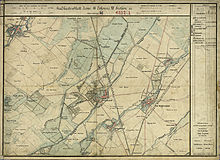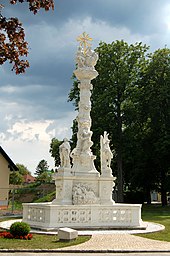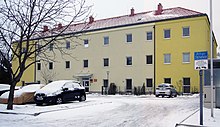Trumau
|
market community Trumau
|
||
|---|---|---|
| coat of arms | Austria map | |
|
|
||
| Basic data | ||
| Country: | Austria | |
| State : | Lower Austria | |
| Political District : | to bathe | |
| License plate : | BN | |
| Surface: | 18.56 km² | |
| Coordinates : | 48 ° 0 ' N , 16 ° 21' E | |
| Height : | 202 m above sea level A. | |
| Residents : | 3,709 (January 1, 2020) | |
| Population density : | 200 inhabitants per km² | |
| Postal code : | 2521 | |
| Area code : | 02253 | |
| Community code : | 3 06 41 | |
| NUTS region | AT127 | |
| Address of the municipal administration: |
Kirchengasse 6 2521 Trumau |
|
| Website: | ||
| politics | ||
| Mayor : | Andreas Kollross ( SPÖ ) | |
|
Municipal Council : ( 2020 ) (23 members) |
||
| Location of Trumau in the Baden district | ||
| Source: Municipal data from Statistics Austria | ||
Trumau is a market town with 3709 inhabitants (as of January 1, 2020) in Lower Austria in the Baden district .
geography

The Triesting flows through the municipality . The market town lies between the southwest and northeast parts of the Vienna Basin at an altitude of 202 m above sea level. A. In Trumau, 3709 people live on an area of 18.57 km² (as of January 1, 2020).
history
The place was brought into being in the High Middle Ages by Leopold IV from Babenberg through a donation to the Heiligenkreuz Abbey and is documented in 1139. After the first few years of monastic life in Heiligenkreuz, Abbot Gottschalk saw no prospect of financial sustainability for the young founding of the monastery and therefore asked the ruler to add the Trumau estate, a classic monastic grangie .
After the settlement was devastated in the second half of the 15th century, the Grangie suffered further serious damage in the Turkish years 1529 and 1683. A new settlement by Croatian farmers took place around 1550–1600. In the course of the resettlement, Trumau was raised to a parish in 1588. The foundation came about in connection with the Counter Reformation in the second half of the 16th century. Both the sovereign Emperor Rudolf II and Bishop Urban von Trennbach , the head of the Diocese of Passau , gave Abbot Ulrich Molitor permission to build it in 1583 . Until then, the area was part of the Traiskirchen parish , which in turn is incorporated into Melk Abbey. In 1588 the Trumau church was consecrated. Since then, the parish has mostly been looked after by a priest monk from the Heiligenkreuz convent. They have been documented by name since 1613. The rectory fell victim to the flames of 1683.
In the Trumau cemetery there is a Russian military cemetery consisting of a mass grave. There is no information on the number of Soviet soldiers buried here in April 1945.
- Place name
The Middle High German word "drum" means end piece. In this case, the name could indicate the end of a floodplain landscape , which can be deduced from the geographic location of the drier southwest and the wetter northeast part of the Vienna Basin.
In historical sources the current place name appears in various forms. The vernacular has often spoken of "drumðo".
coat of arms
Blazon : In a blue shield, a natural-colored hand ready to take an oath, which hovers over two crossed silver hammers.
The coat of arms of the market town of Trumau originally consisted of a blue shield on which a broad, skin-colored oath hand could be seen, which is supposed to remind of the solemn oath of Margrave Leopold IV. In 1971 another element was awarded. Since then, two crossed silver hammers and above the oath hand can be seen in the coat of arms. The new elements symbolize industry and commerce. The importance for Trumau of the positive development of industry and commerce in the 19th and 20th centuries was decisive for the awarding of these symbols.
Population development
| census | Residents |
|---|---|
| 2011 | 3,332 |
| 2001 | 2,507 |
| 1991 | 2,199 |
| 1981 | 1.933 |
| 1971 | 1,880 |
Source: population development of Trumau. (PDF) Statistics Austria
politics
The municipal council has 23 members. With the municipal council elections in Lower Austria in 1990, the municipal council consisted of the following 21 members: 17 SPÖ, 3 ÖVP and 1 alternative list Trumau (Greens). There were minor changes by 2020. The status in 2020 was: 17 SPÖ, 3 FPÖ, 2 ÖVP and 1 Greens.
- mayor
- 1965–1987 Johann Wedl (SPÖ)
- 1998-2013 Otto Pendl (SPÖ)
- since 2013 Andreas Kollross (SPÖ)
Attractions

Parish church
The abbot of Heiligenkreuz initiated the construction of the church in the 16th century and engaged the master builder “Maister Andre Stuber zu Paden”. The stone carving was carried out by Italian masters , the brothers Elias and Alexius Payos from the monastery’s own quarry . It was completed under Abbot Johannes Rueff . Bishop Hector von Passau consecrated the post-Gothic Trumau parish church on February 22, 1588 under the patronage of John the Baptist . The church building was enlarged in 1845.
lock
A moat, a dam and a mill with a mill stream probably existed in connection with the grangie in the 12th century. Towards the end of the First Austrian Turkish War (between 1548 and 1558) the enclosed courtyard was rebuilt; numerous renovations and new buildings took place. Under Gábor Bethlen in 1621, Hungarian rebels burned the building down. In 1650, at the instigation of Abbot Michael Schnabel, the reconstruction began and ended in 1667. Emperor Leopold I stayed several times in Trumau Castle, which also served as an administration building, school and parsonage. In the course of the Fifth Austrian Turkish War in 1683 the castle was badly damaged. During the subsequent renovations, the towers were significantly changed. The castle was damaged several times by fires. Historically secured fires occurred in 1811 and 1880; others came along. The original pointed roof was replaced by a flatter one during the restoration. In the years 1993 to 1995 extensive restorations were carried out on the castle, during which two sundials in the inner courtyard could be exposed. Attempts have been made to adapt the towers to an engraving by Georg Matthäus Vischer from 1672 . The International Theological Institute for Studies on Marriage and Family (ITI for short) has been located on the grounds of the palace since 2009 .
Plague column
The plague / Trinity column, erected between 1720 and 1730, originally stood at the main intersection of the community next to the bell tower. In the course of a renovation in 2007, it was set up around 200 m away at the rectory.
economy

(by Ferdinand Georg Waldmüller )
With the cooperation of the Vienna lawyer Josef August Eltz (1788-1860) was with the statutes of 17 July 1838 Actiengesellschaft the cotton spinning factory Trumau founded the m at a branched from the Triesting 4246 long Werkkanal one over the district under the Vienna woods far beyond significant Spinning mill built. In the first few years this consisted of three main buildings: the 101 m long spinning mill, across the axis of the canal (at Liliengasse 8), and two 40 m by 25 m large residential buildings, symmetrical on both sides of the (with a walkway) Located in the canal: east of the (later two-courtyard and existing until the early 1990s) workers' housing complex Matschakahof ; to the west is the former factory office (Nelkengasse 8), which is still used today as a residential courtyard . On November 20, 1863, under commercial law, the name Actiengesellschaft der k. k. priv. cotton-fine-spinning-factory registered in Trumau , on January 22nd, 1864 corporation of the k. k. priv. cotton fine spinning factory in Trumau , based in Vienna, and the branch to Trumau and Marienthal with which (since at least 1859 , de facto the Trumauer work with the given) Association Marienthal textile factory verbüchert may have been. The cotton mill existed until 1928.
In Trumau there are several steel and aluminum construction companies as well as the machine warehouse of a very large construction company. The central warehouse of the Hofer retail chain and two car, trading and service companies are on the outskirts of the village. As one of the first municipalities in Lower Austria, Trumau has had a public charging station for electric cars since April 2013 , where drivers pay for charging with green electricity with a fuel card using contactless RFID technology.
- wine growing
The grape varieties Neuburger , Grüner Veltliner , Burgunder , Chardonnay , Silvaner , Muscat-Ottonel , Zweigelt , Blauer Portugieser and Blauburger are grown in Trumau . The wines are mainly sold at the Heuriger . Buschenschank have the Heurigen Artner, Heimhilcher, Mairinger Karl and Scheibenreif alternating on the dates given.
education
Personalities
- Sons and daughters of the church
- Otto Effenberger , ARBÖ General Secretary
- Franz Großbauer , forestry teacher
- Erich Gruber , lawyer, politician and SS brigade leader
- Friedrich Florian Grünberger , architect
- Karl Hess , physicist
- Andreas Kollross , SPÖ politician, member of the National Council
- Otto Pendl , SPÖ politician, member of the National Council
- Johann Wedl , SPÖ politician, member of the state parliament
- Johann Wurth , teacher, poet and folklore collector
- People related to the community
- Dieter Brosz , green politician
- Bernhard Dolna , theology and Judaist, lecturer in Trumau
- Larry Hogan , theologian, lecturer in Trumau
literature
- Hermann Watzl , Albert Urban (photographer): Trumau Castle. Its building history (Heiligenkreuz / Vienna 1964).
- Kurt Janetschek: Trumau through the ages. A chronicle, written on the occasion of the market survey on June 4, 1972 (Trumau an der Triesting 1972).
- Historical and topographical representation of Baden and the Heiligenkreuz Abbey and the surrounding area with special consideration for parishes, abbeys, monasteries, charitable foundations and monuments (topography of the Archduchy of Austria, or representation of the emergence of cities, markets, villages and their fates 4, Vienna 1829 ), Pp. 309-312.
- Dehio manual. The art monuments of Austria. Lower Austria south of the Danube (Horn / Vienna 2003), pp. 2390–2394.
- Lower Austrian Document Book (St. Pölten 2013), Vol. 2, pp. 721–723.
Web links
- 30641 - Trumau. Community data, Statistics Austria .
- Trumau. Municipality data, statistical data and mandate distribution on the website of the Lower Austrian state government.
Individual evidence
- ↑ "drum: (stn.) End piece, end, limit. - see. engl. thrum ; lat. terminus ; Greek terma, tormos “from: Georg Benecke, Wilhelm Müller, F. Zarncke: Middle High German Dictionary , Volume 1, Hildesheim, Zurich, New York, 3rd reprint of the Leipzig 1854 edition
- ↑ Between 1137 and 1340 Trumowe , 1139 Drumau , 1178 Drumawe , between 1233 and 1294 Drumowe , between 1303 and 1306 Drumbuowe , 1340 Drumenaw , 1380 Drumpnaw , 1388 Drumpnow , 1463 Trumaw , 1548 Thrumbaw .
- ↑ Results of the municipal council election 2020 in Trumau. Office of the Lower Austrian State Government, January 26, 2020, accessed on April 4, 2020 .
- ↑ Stiftsarchiv Heiligenkreuz: Stone works in the churches of Drommau , 51 / IV / 14.
-
↑ a b Mixed messages. (...) † On the 9th of December M. died in Mauer Dr. Joseph August Eltz (...). In: Wiener Zeitung , No. 214/1860, September 12, 1860, p. 3582, bottom center. (Online at ANNO ). ;
Announcements. (...) Changes in the companies. In: Official Journal of the Wiener Zeitung , No. 223/1860, September 22, 1860, p. 461, bottom center. (Online at ANNO ). . - ^ Company minutes. (...). In: Official Journal of the Wiener Zeitung , No. 231/1863, October 8, 1863, p. 563, column 4 above. (Online at ANNO ). .
- ^ Company minutes. (...). In: Official Journal of the Wiener Zeitung , No. 275/1863, November 28, 1863, p. 839, column 4 below. (Online at ANNO ). .
- ^ Company minutes. (...). In: Official Journal of the Wiener Zeitung , No. 25/1863, January 31, 1864, p. 165, column 2 below. (Online at ANNO ). .
- ↑ Trade, transport, industry, etc. s. w. (…) B. Representative of the industry (…) Gustav Hagemacher, director of the spinning factories in Trumau and Marienthal (…). In: Klagenfurter Zeitung , No. 169/1859, July 28, 1859, p. 676, column 2 middle. (Online at ANNO ).
- ↑ Manfred Hösch: Location typology of industrial enterprises in the district under the Vienna Woods to 1850. Dissertation. Technical University of Vienna, Baden near Vienna 1984, text volume, p. 393 f., Online (PDF; 17 MB) ; Photo book, Plan 127, online (PDF; 11 MB) .
- ↑ Opening of the first charging station in Trumau . In: Trumau community news . No. 301 , April 2013, p. 1 ( trumau.at [PDF; 1.4 MB ; accessed on March 30, 2019]).








